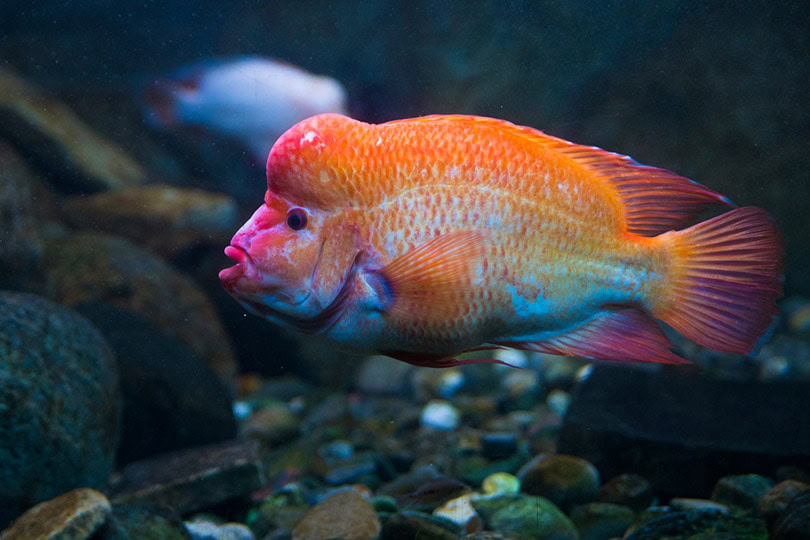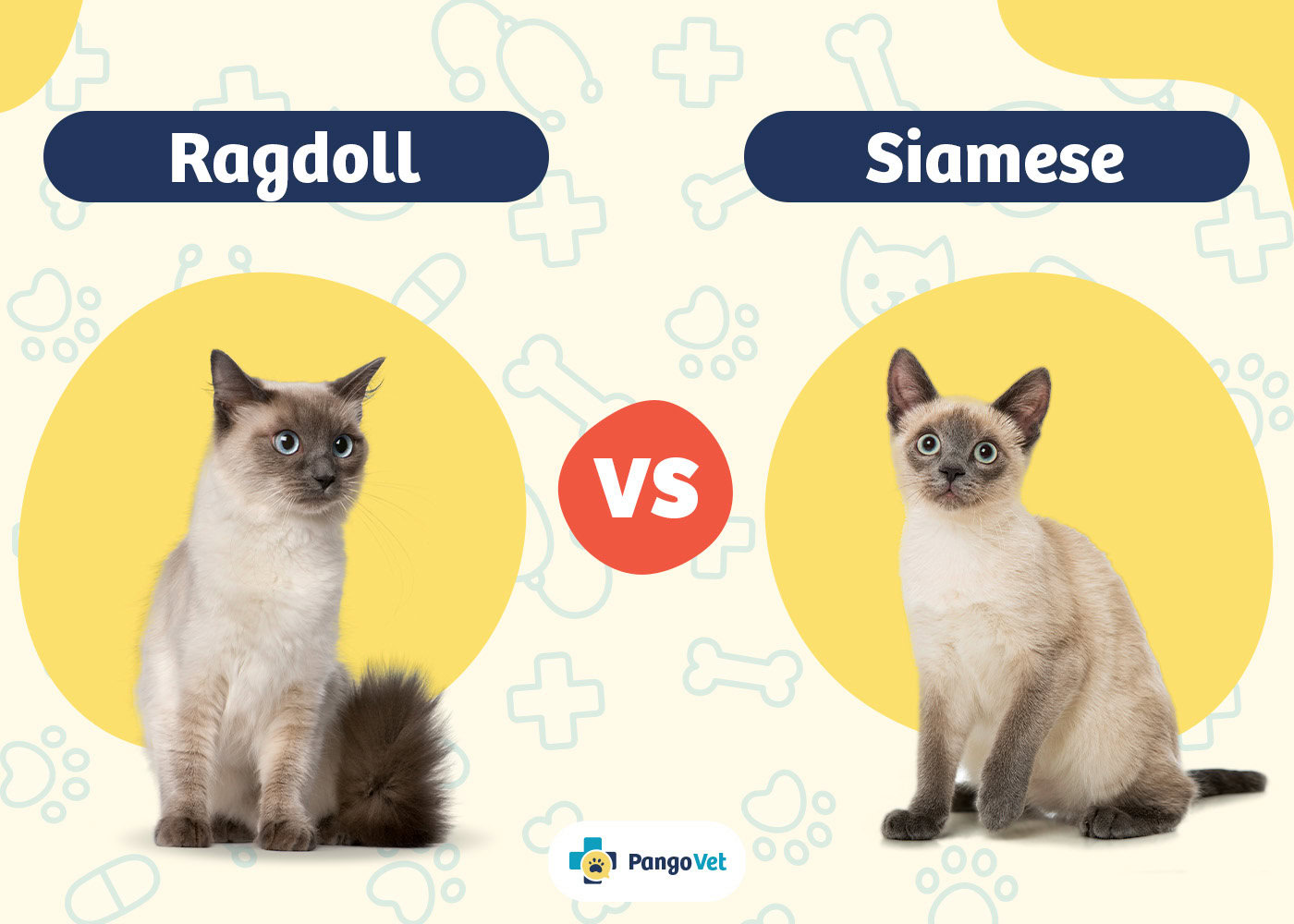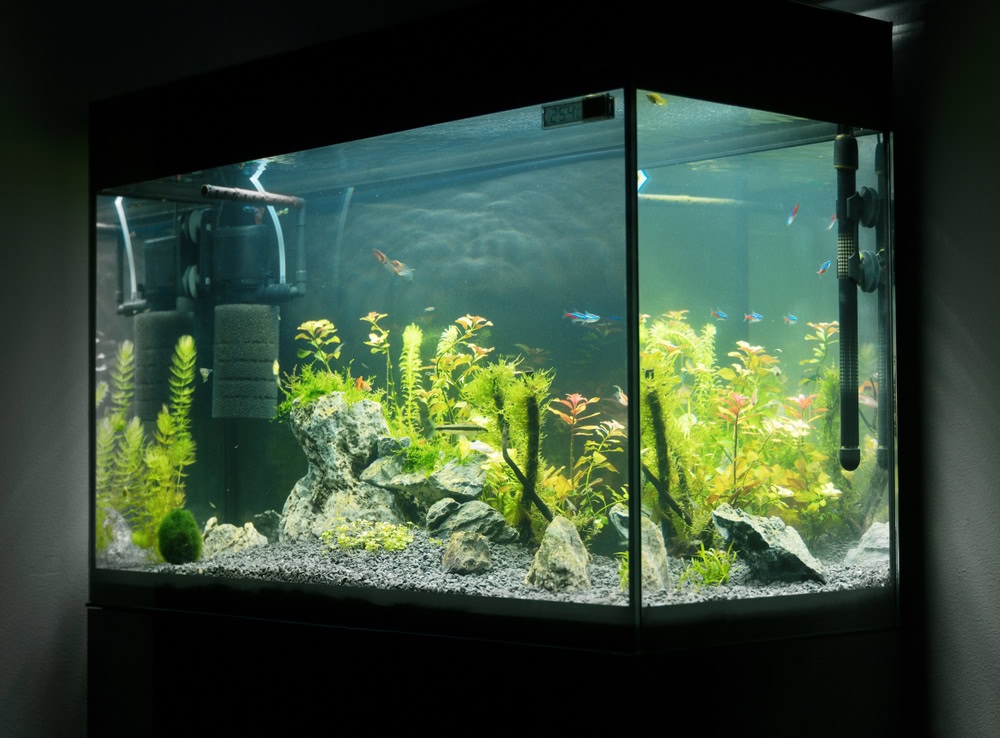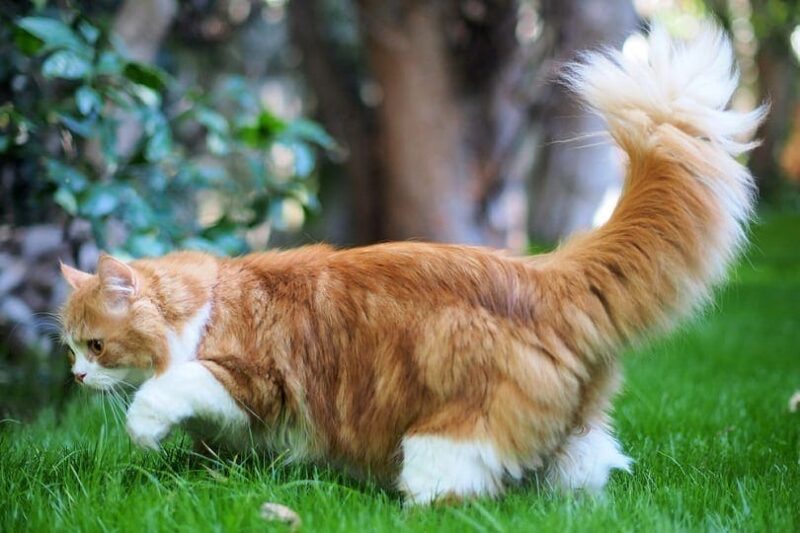Click to Skip Ahead
Red Devil Cichlids (Amphilophus labiatus) are a popular fish for aquarists because they are interesting to look at and have a personality that pops. Although their personality is fun for us, it isn’t so great for many other tank mates. These feisty fish are aggressive to other fish and will eat many tank mates if given the chance. So, you must choose Red Devil Cichlid tank mates selectively. However, it’s best to keep your Red Devil by itself.
So that you don’t have to research every fish on the planet by yourself, we tell you about the four best options for tank mates for Red Devil Cichlids in this article.

The 4 Best Tank Mates for Red Devil Cichlids
Overall, we do NOT recommend getting a tank mate for your Red Devil Cichlid. However, here are some examples of fish that may be able to hold their own against the Red Devil:
1. Other Red Devils

| Size: | 15 inches |
| Diet: | Omnivore |
| Minimum Tank Size: | 55 gallons for 1 fish, 100+ gallons if you get a tank mate |
| Care Level: | Expert |
| Temperament: | Aggressive (it’s best on its own) |
If you must put a tank mate in with your Red Devil Cichlid, it’s best to pick another Red Devil of the opposite sex. Interestingly, Red Devil Cichlids are monogamous. So, the males and females get along if they are kept in pairs.
For best results, introduce the fish to one another early on, though male and female Red Devil Cichlids get along later in life too. Never get two male Red Devil Cichlids, though. The males are extremely territorial and are guaranteed to fight.
2. Firemouth Cichlid
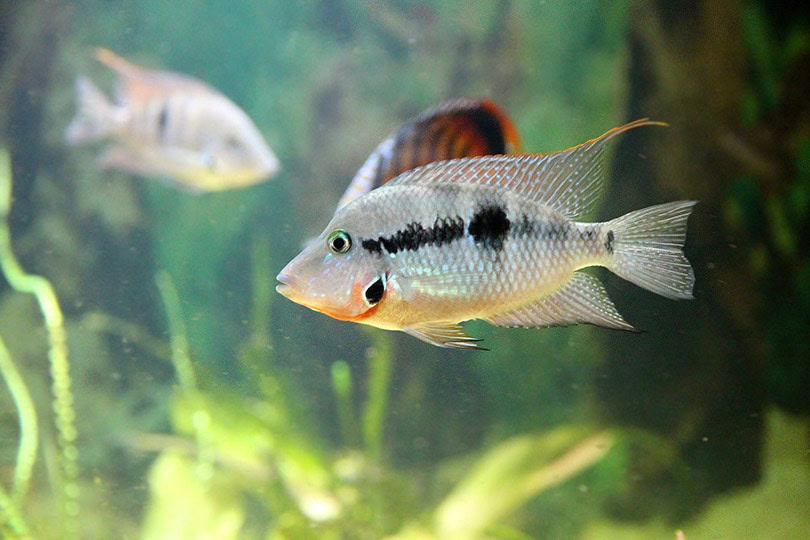
| Size: | 6 inches |
| Diet: | Omnivore |
| Minimum Tank Size: | 30 gallons |
| Care Level: | Beginner |
| Temperament: | Semi-aggressive, aggressive mainly during breeding |
The Firemouth Cichlid is another fish you can pair with a Red Devil. Its water parameter needs are similar, and they are much easier to keep than other Cichlids. In fact, this is considered the beginner Cichlid pick.
During breeding time, Firemouths can be territorial, but they are far less aggressive than other Cichlids. Their more docile nature means that they are less likely to get into a fight with the Red Devil than other Cichlids.
The one downside of Firemouths is that they only grow to be about 6 inches. This size is smaller than the Red Devil. On the one hand, the size is large enough that the Red Devil isn’t likely to pick a fight without a reason. On the other hand, the Red Devil is likely to win the fight if it decides to start one.
3. Convict/Zebra Cichlid
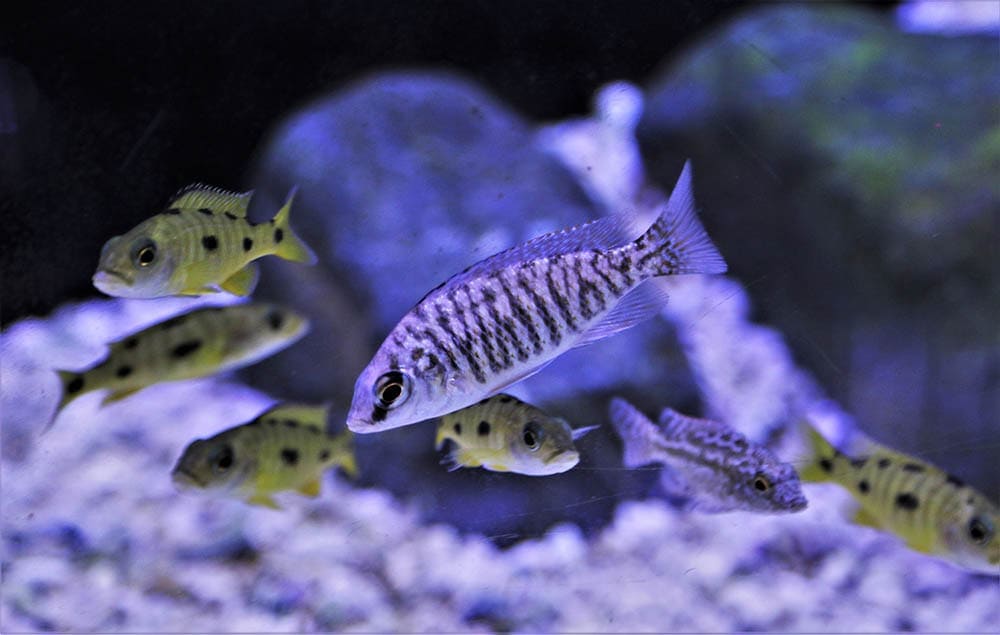
| Size: | 4 inches |
| Diet: | Omnivore |
| Minimum Tank Size: | 30 gallons |
| Care Level: | Medium |
| Temperament: | Semi-aggressive, aggressive mainly during breeding |
Convict Cichlids, sometimes called Zebra Cichlids, can be kept with a Red Devil with caution. This Cichlid grows to be about 5 inches long, which means it runs into the same problem as the Firemouth Cichlid.
The Convicts are similar to the Firemouths in more ways than one. They are also considered semi-aggressive because they are primarily only aggressive when breeding. That said, the Convicts are slightly more aggressive than Firemouths.
When placed with a Red Devil, the Convict Cichlid will be able to stand up for itself if needed, but its smaller size means that it is less likely to fight with the Red Devil and vice versa.
4. Jaguar Cichlid
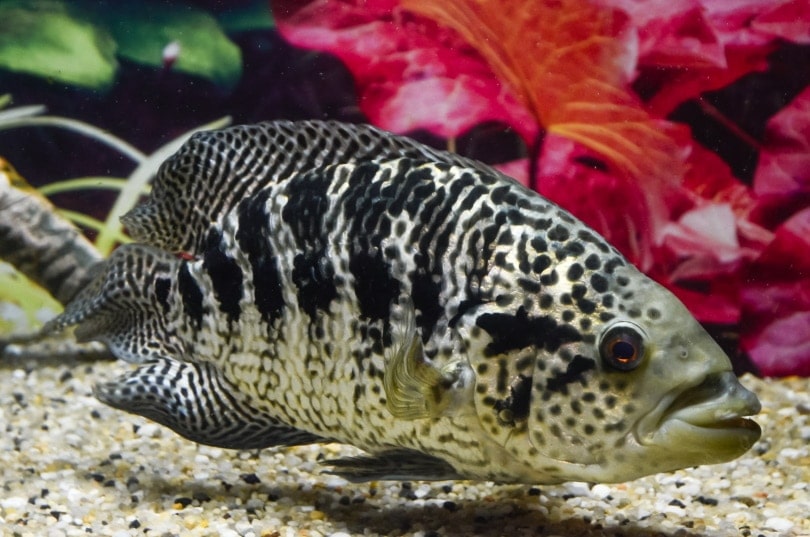
| Size: | 16-25 inches |
| Diet: | Carnivore |
| Minimum Tank Size: | 70 gallons for 1 |
| Care Level: | Expert |
| Temperament: | Aggressive |
The Jaguar Cichlid is a large fish that is native to Honduras and Costa Rica. These fish are about the same size as the Red Devil, making it less likely that the Red Devil will attack or eat the Jaguar.
Jaguar Cichlids are aggressive too, but they mainly prefer small fish and invertebrates. Consequently, they aren’t as likely to attack the Red Devil either. If either fish becomes aggressive, both the Red Devil and Jaguar will be able to defend themselves, which is both a benefit and a drawback.
It can be difficult to house Red Devils and Jaguars together because they have different water parameter needs. Jaguars need a higher pH and a lower hardness.

What Makes a Good Tank Mate for Red Devil Cichlids?
Generally speaking, Red Devil Cichlids do better without any tank mates. Especially if you have had your Cichlid for a long time, it’s best to leave it by itself. Life without a tank mate might seem lonely to us, but it’s how they would prefer to keep it.
You can have a tank mate for your Red Devil Cichlid if you select the mate wisely and introduce them to one another from an early age. Young Red Devils are more flexible and likely to get along with a tank mate. The tank mate must be the same size or larger than the Red Devil and able to defend itself too.
If you choose to get a tank mate for your Red Devil Cichlid, you will need a massive tank. Even if the tank mate is a suitable species and is introduced when the Cichlid is still young, it won’t stand a chance if the tank is too small. When it comes to territorial fish species, each individual needs enough room to have a clearly defined territory, as well as a buffer zone, if you hope to avoid constant conflict.
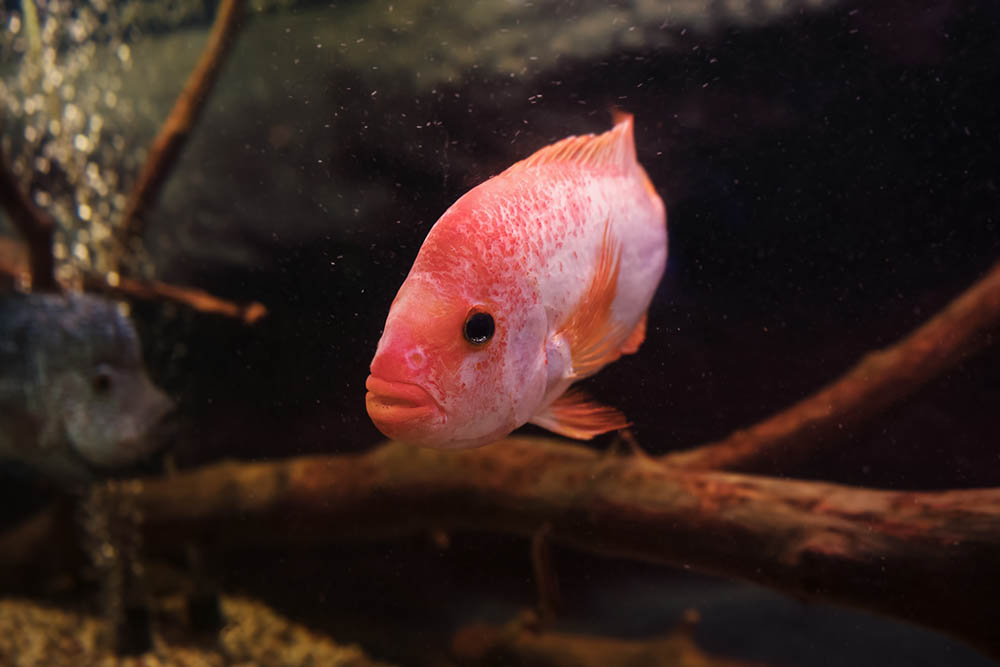

Where Do Red Devil Cichlids Prefer to Live in the Aquarium?
Unlike other fish, Red Devil Cichlids are avid swimmers and don’t stay in one spot. Often, Red Devil Cichlids are lured to different parts of the tank due to their surroundings. For example, they may go to the middle if there is foliage or dive all the way down to play in the gravel.
One place that you can expect to find Red Devil Cichlids is in hides. These fish love to hang out in crevices, like rock and wood. These spots give the Red Devils a place to hide in case of attack. Make sure to put some hides in the tank!
Water Parameters
Red Devil Cichlids are native to three Nicaraguan lakes. As you would expect from South America, this area is very warm, resulting in warm water.
As a result, these fish can be difficult to care for as a new fish owner because they have particular water parameters that must be met. Red Devil Cichlids need water between 75 and 79 degrees Fahrenheit. More so, the pH level should be between 6.5 and 7.5 and the hardness should be 6 to 25 dGH.
Size
Red Devil Cichlids are big fish. Growing to be 15 inches long on average, they can easily fight, kill, and swallow smaller fish. This fish’s size, matched with its aggression, makes it a fighting machine where fish are concerned. You can expect your Red Devil to reach full length by the time it is three years old.
Aggressive Behaviors
Red Devil Cichlids are known for being aggressive to other fish. Even fish of the same species are often seen as the enemy due to extreme territorial behavior. Red Devil Cichlids will fight one another and other fish as a result.
Red Devil Cichlids are so aggressive that they will “fight” almost anything they can get ahold of. This includes pebbles, foliage, or food that falls into the tank. When not fighting, these fish will swim in their free time.
Because Red Devil Cichlids swim so much, note that they will become more aggressive if their tank is not suitable for their needs. In other words, they will act more hostile if the tank is too small.

Reasons for Having Tank Mates for Red Devil Cichlid
Because of how aggressive Red Devils are, there aren’t a whole lot of benefits for getting it a tank mate. That being said, there a few benefits that might interest you:
1. A Livelier Tank
With more than one fish in the tank, the tank will certainly be livelier. However, if you are after a more interesting and lively aquarium, you will be far better off choosing a less aggressive species, like a Severum cichlid or Yellow Lab.
2. Brag About Having a Docile Red Devil
If you can successfully introduce a tank mate to your Red Devil, you have overcome a large obstacle—ensuring your Red Devil is docile enough to be around another fish. If you have accomplished this feat, brag about it!
3. Breed Red Devils
If you have succeeded in making a friendly introduction between a male and female Red Devil, the pair is likely to breed.
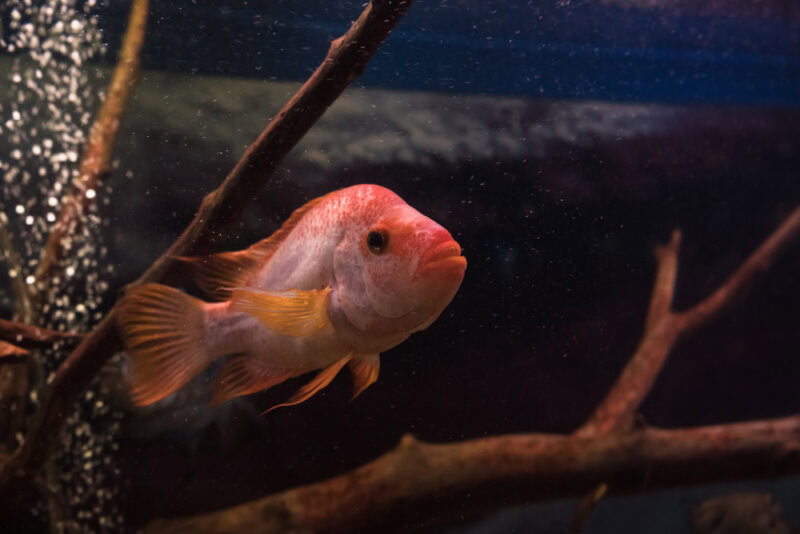
Red Devils and People
Even though Red Devils are aggressive towards other fish, they are surprisingly known for bonding with humans. In fact, some Red Devils have been known to beg for food much like a dog. It is because of this fact that the Red Devil’s aggressiveness towards other fish comes as a shock to many owners.

Conclusion
Even though some fish can be kept as tank mates for your Red Devil, we would advise against it. Because Red Devils are so aggressive, it is difficult for them to get along with any fish, even the fish mentioned above.
If you must get a tank mate for your Red Devil, go with a fish that is large and can hold its own. Though the fish will still likely fight, it hopefully won’t be to the death. Nevertheless, just leave your Red Devil Cichlid by itself to make things easier for everyone involved.
Featured Image Credit: Mircea Costina, Shutterstock
